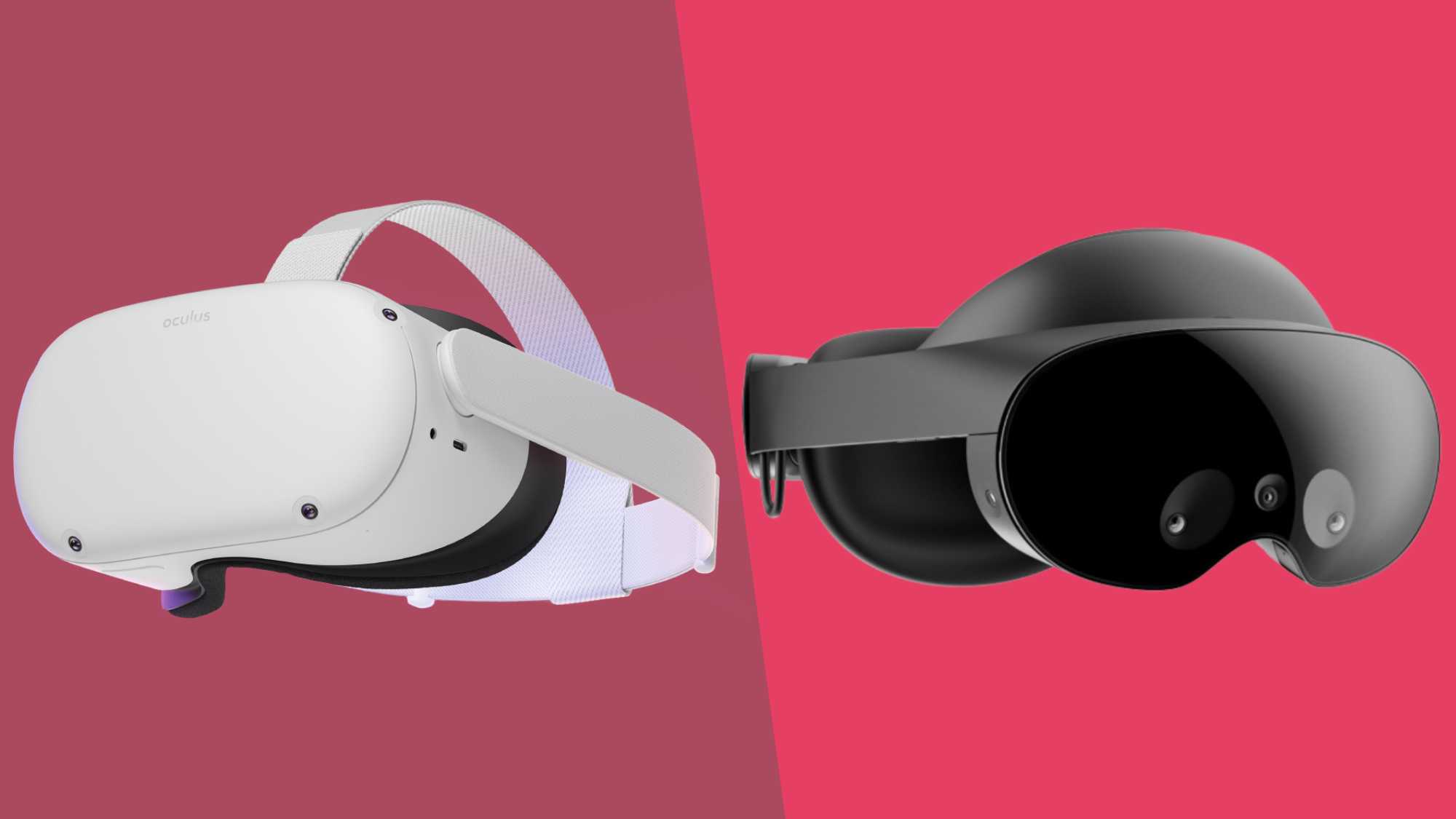Oculus Quest 2 vs Meta Quest Pro: which Meta VR headset is the best for you?
Does Meta’s new headset Pro-ve its worth against the Quest 2?

The world of VR is lousier with headsets than it was a few years ago, with Meta now offering two similar but very different options with its Meta Quest Pro and Oculus Quest 2 (now officially known as the Meta Quest 2).
Both headsets run on the same Quest platform – giving you access to a bevy of excellent apps and many of the best VR games out there – plus, both devices are standalone (meaning you won’t need to tether them to a PC or a console like the Valve Index or PSVR 2). But the Quest Pro has a few technical upgrades with better specs and new features like eye-tracking and improved mixed reality – however, these come at a higher cost.
So which device is better for you? We’re here with our Oculus Quest 2 vs Meta Quest Pro guide to help answer that very question. For a more in-depth look at each headset be sure to check out our Oculus Quest 2 review as well as our Meta Quest Pro review.
Oculus Quest 2 vs Meta Quest Pro: Price
Let’s get the most significant difference out of the way first; the Meta Quest Pro is considerably more expensive than the Oculus Quest 2.
Currently, the Quest 2 comes with two models; its version with 128GB of storage will set you back $399.99 / £399.99 / AU$629.99, while its 256GB version will cost you $429.99 / £429.99 / AU$719.99. By comparison, the Meta Quest Pro has only one model (which comes with 256GB of storage) and you’ll have to pay $999.99 / £999.99 / AU$1,729.99 to pick it up.
While the Quest Pro is $500 / £500 / AU$720 cheaper than it was at launch – following a surprise price Cut Meta gave its VR headsets in March 2023– it’s still over double the price of either Quest 2 model. So if affordability is your most important factor then clearly the Quest 2 is the better Meta headset for you.
That said, the Quest Pro does offer a few upgrades that might make its price more worthwhile.
Get daily insight, inspiration and deals in your inbox
Sign up for breaking news, reviews, opinion, top tech deals, and more.
Oculus Quest 2 vs Meta Quest Pro: Design
The first area where you can see why the Quest Pro deserves its name is its design improvements. That’s not to say the design of the Oculus Quest 2 is terrible, but it certainly has its fair share of faults compared to Meta’s newer headset.
For a start, the Quest 2 is very front-heavy – all of the components are stored in the big box that covers your eyes – and the strap is fine, but doesn’t do a very good job of counterbalancing the weight. The Meta Quest Pro solves this problem by swapping the elastic strap for a padded plastic one – which holds the headset to your head more securely – and moving the battery from the headset’s front to the back (placing it in the strap).
This design means the Quest Pro spreads its weight across your head better, helping it to feel lighter and comfier than the Quest 2 despite it weighing more. The Meta Quest Pro weighs 722g, while the Oculus Quest 2 only weighs 503g.
Another improvement the Quest Pro makes is to its controllers. Not only are the handsets rechargeable – meaning you no longer need to stock AA batteries for your VR headset – but they’re better at tracking too. That’s because instead of using a tracking ring like the Quest 2’s controllers – which the headset’s cameras follow to know where your hands are – the Quest Pro’s controllers have their own in-built cameras and tracking capabilities. This means that the tracking is more accurate, that the Quest Pro can still know where your hands are when the controllers are out of sight, and that you aren’t as likely to accidentally bump one controller into the other when your hands are close together. The Quest Pro’s controllers also have a much more premium, less plasticky feel.
Unfortunately, one change the Quest Pro makes to its design might be less universally liked. Rather than creating a seal around your eyes like the Quest 2, the Quest Pro leaves a gap that allows you to see the real world at all times. When testing the headset for our Meta Quest Pro review we found this design was perfect for mixed-reality experiences, however, it can impact immersion when in VR. Our reviewer personally didn’t have much of an issue – especially when using the optional blinders that block your vision to the left and right of the headset – but others have found the constant view of the real world too distracting.
You can purchase an optional add-on for the Quest Pro that completely blocks out the real world, but that’s an added cost you might not want to pay for the already expensive gadget.
Oculus Quest 2 vs Meta Quest Pro: Specs
The Meta Quest Pro is a premium headset with some solid specs; it boasts 12GB of RAM, a Snapdragon XR2+ chip, and 256GB of storage. By comparison, the Oculus Quest 2 has only 6GB of RAM and a regular XR2 chipset (which is about half as powerful as the XR2+), but it does offer 256GB of storage or a cheaper 128GB version – which is probably more than enough storage space frankly.
Meta’s newer Quest Pro also uses better displays; it has two mini-LED screens (one per eye) that are each 1800 x 1920 pixels and that offer 37% more pixels per inch and 10% more pixels per degree than the Quest 2’s panels – which should help to counteract the annoying screen door effect. The Quest 2 technically has a slightly better resolution, with its panels being 1832 x 1920 pixels (though it is more prone to the screen door effect), plus the Quest 2’s displays can run at 120Hz rather than the 90Hz the Quest Pro limited to.

Most people say that 90Hz is the minimum refresh rate VR needs to not induce motion sickness simply by you wearing the headset, but smoother 120Hz gameplay will look even smoother and less disorienting – though running at this higher refresh rate will tear through your Quest 2’s battery life.
Oculus Quest 2 vs Meta Quest Pro: Battery life
Speaking of, oddly the Oculus Quest 2 has the superior battery life of the two Meta VR headsets. It comes in with an average time between charges of two to three hours, while the Quest Pro can only offer you one and a half to two hours between charges. If you purchase the Quest 2’s optional elite strap with battery add-on – which upgrades the Quest 2’s strap to be more like the Quest Pro’s – then you can eke out another hour or so of charge from the device.
Meta has argued that most people don’t need to have a headset that can last for hours and hours, but if you’re looking for a VR device that will serve you well for longer play sessions without needing to be tethered to a power source then the Quest 2 is what you need.
Oculus Quest 2 vs Meta Quest Pro: Features
Because the Quest 2 and Quest Pro both run on Meta’s Quest platform you’ll find they share a lot of features and software. All the best Oculus Quest 2 games also run on the Quest Pro, both headsets offer hand tracking, and you can turn on Oculus Move data on either device to track your VR fitness goals.

The Meta Quest Pro however has a few features that are unique to it that give it an edge over the Quest 2.
For one it has full-color passthrough; this means that when you use the Quest Pro’s mixed reality abilities you’ll see a live video feed of the real world around you in color – whereas the same feed on the Quest 2 would be in grayscale. Additionally, the Quest Pro has face-tracking and eye-tracking. This allows your VR avatars to mimic your actual expressions, and games could use tracking for foveated rendering – a technique that would make them more efficient with processing power and allow for larger, more complex VR titles.
Unfortunately, the Quest Pro doesn’t yet have much software that makes good use of its additional features, making them feel like an expensive novelty.
Oculus Quest 2 vs Meta Quest Pro: Conclusion
In terms of raw performance, comfort, and feature set the Meta Quest Pro is the clear front-runner. But with sub-par battery life and high price – alongside some of its features feeling underused – and you might feel it doesn’t offer the best bang for your buck.
The Oculus Quest 2 is far more budget-friendly, and while it does lack the Pro’s upgrades it’s still a really solid VR headset. It’s better value for money, and if you can’t afford to splash out on the Pro you shouldn’t be disappointed by the Quest 2.
Alternatively, you could decide to pick up neither and wait for the Oculus Quest 3 – which is due to launch later this year based on Meta’s comments.

Hamish is a Senior Staff Writer for TechRadar and you’ll see his name appearing on articles across nearly every topic on the site from smart home deals to speaker reviews to graphics card news and everything in between. He uses his broad range of knowledge to help explain the latest gadgets and if they’re a must-buy or a fad fueled by hype. Though his specialty is writing about everything going on in the world of virtual reality and augmented reality.